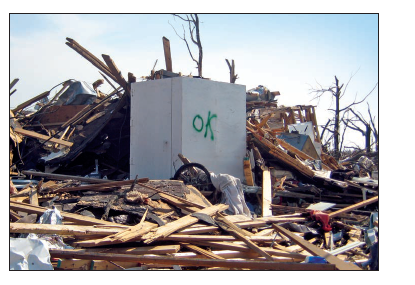A safe room is a hardened structure specifically designed to meet the Federal Emergency Management Agency (FEMA) criteria and provide near-absolute protection in extreme wind events, including tornadoes and hurricanes.
Near-absolute protection means that, based on our current knowledge of tornadoes and hurricanes, the occupants of a safe room built in accordance with FEMA guidance will have a very high probability of being protected from injury or death.

Summary of FEMA Safe Room Activities
Every year, tornadoes, hurricanes, and other extreme windstorms cause numerous injuries and deaths in the United States. FEMA provides guidance and best practices on safe room design, construction, related standard and building code development and identifying grants for safe rooms. Read more details in the latest fact sheet.
Safe Room Resources
Funding
FEMA provides hazard mitigation funding to eligible applicant states, tribes and territories. They then provide subgrants to local governments to assist in reducing overall risk to people and property.
Resources and Publications
- Understand why you may need a safe room in your home or community.
- View our suite of safe room resources and publications.
- Read the frequently asked questions about safe rooms.

Read hazard mitigation best practices for examples of mitigation in action.
Notices
Notification: FEMA-funded Prefabricated Residential Safe Room Compliance Requirements
Following publication of FEMA P-361 (2021), FEMA’s Hazard Mitigation Assistance Branch provided an extended grace period for prefabricated residential safe rooms to comply with the testing, listing, and labeling requirements of ICC 500-2020 as referenced in FEMA P-361 (2021).
Be advised that the extended grace period allowing FEMA-funded prefabricated residential safe rooms to comply with FEMA P-361 (2015) and ICC 500-2014 expired on January 1, 2024. Accordingly, applications for FEMA-funded prefabricated residential safe rooms must now demonstrate compliance with FEMA P-361 (2021) and ICC 500-2020.
Endorsement Or Approval Of Specific Manufacturers Or Producers
Although FEMA P-320 and P-361 present FEMA’s guidance on the design and construction of safe rooms, FEMA does not verify or certify design calculations or products. The licensed design professional who signs the certification attests that the design or product will meet the requirements specified on the certification. All products must be properly installed for their intended use(s) only. The prescriptive plans for safe rooms provided in FEMA P-320 are not intended to be a substitute for a licensed design professional. Due to the intended function of safe rooms and site-specific conditions that need to be addressed, it is FEMA’s recommendation that a licensed design professional be involved.
FEMA does not endorse, approve, certify or recommend any contractors, individuals, firms or products. Contractors, individuals, or firms shall not claim they or their products are "FEMA approved" or "FEMA certified."
Building Permits
Obtaining proper building permits and inspections is important for all construction. Individuals considering purchasing or installing a safe room should contact their local building official about building code requirements.


